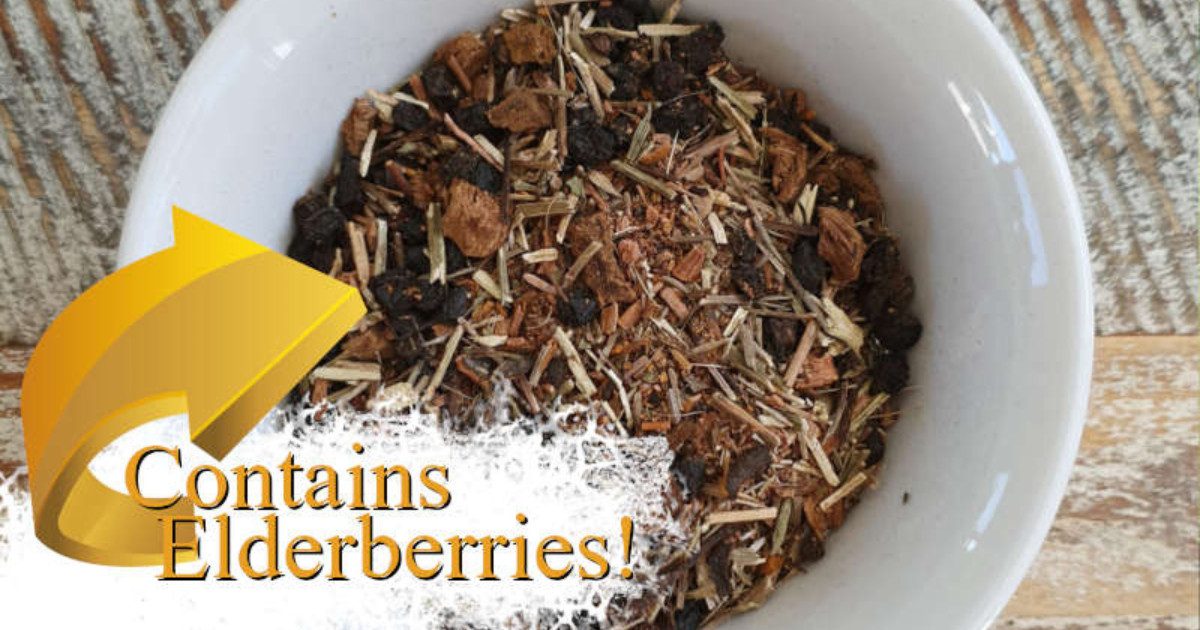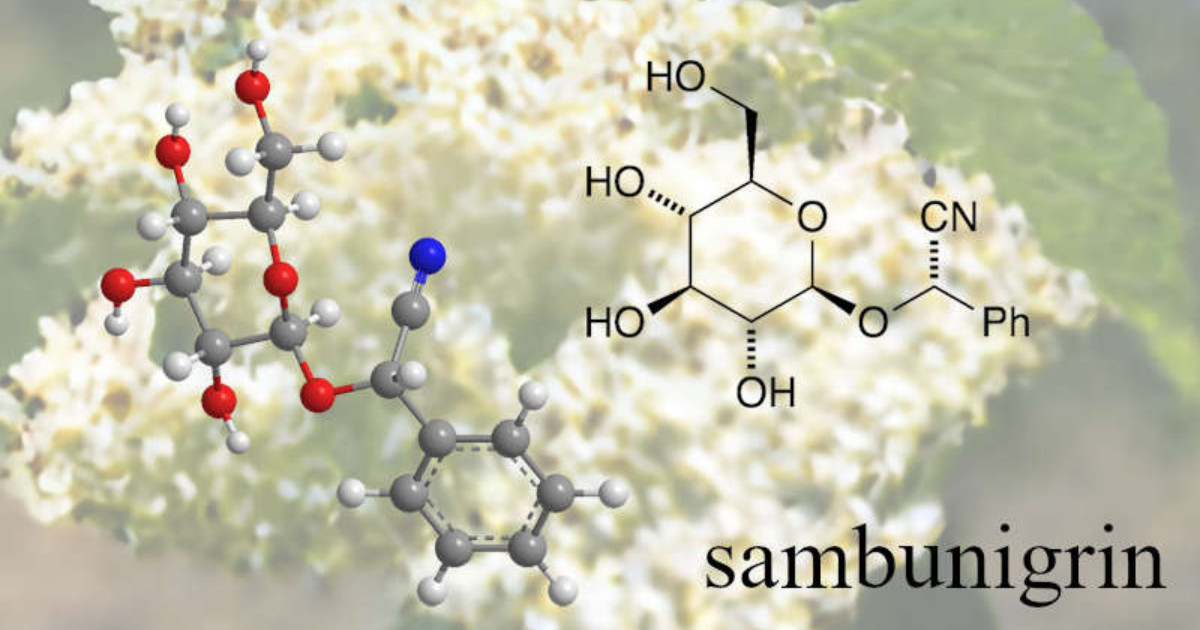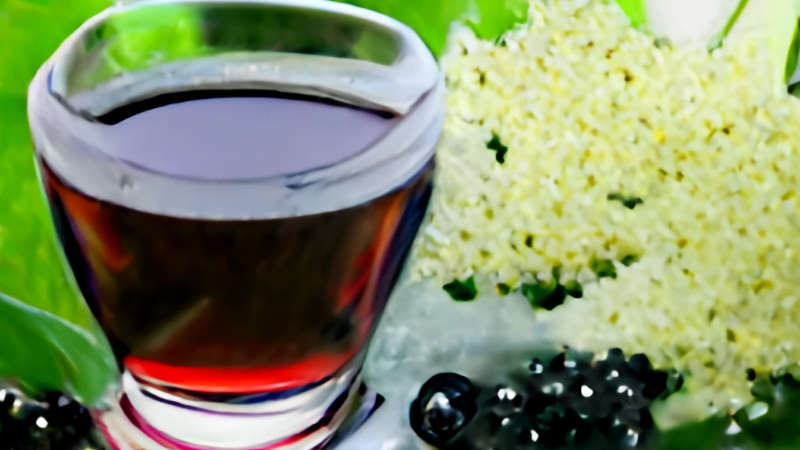There is a fair amount of confusion between elderflower and elderberry. Being able to tell one from the other is important, so we’re going to rummage around in the bushes to find out more about elderflower vs elderberry, and where any benefits can be extracted.
Table of Contents
Is Elderflower Different from Elderberry?
First up, as we jump into the elderflower vs elderberry discussion, is elderberry and elderflower the same thing? No, they are not the same thing. However, elderflower and elderberry are two different parts of the same plant.
Elderflower comes from the elder tree which is known as Sambucus. Coming from the Adoxaceae family, this is a genus of flowing plants.
There are several species of elder trees, including Sambucus nigra, which is the most common species and is native to Europe, and Sambucus canadensis, which is native to North America.
The elder tree is a deciduous shrub or small tree that grows to a height of about 5-12 meters (16-40 feet). It has pinnate leaves and clusters of small, white or cream-coloured flowers that bloom in the spring and summer. The flowers have a sweet, floral aroma and are often used to make tea, syrup, and other products.
The tree also produces small, dark purple berries, which are the elderberries, that are commonly used in cooking and for medicinal purposes.
How does elderflower taste? The taste of elderflower vs elderberry flavor is best described as elderflower has a delicate, sweet, and floral taste. It has a subtle, yet distinct flavor that is often described as being similar to a combination of honey and citrus.
While elderberry has a tart, slightly sweet taste. The flavor of elderberry is often described as being similar to a combination of blueberry and blackberry.
Elderberry is often used to make jam, jelly, wine, and other products. It is also used to flavor liqueurs and other alcoholic beverages.
In cooking, elderberry is often used in sweet and savoury dishes, such as pies, tarts, sauces, and meat dishes. It is also a key ingredient in HerbiTea’s Iron Fluorine Tea blend!

It pairs well with a variety of other flavors, such as honey, citrus, and spices. Elderberry can be eaten fresh, but it is more commonly used in cooked or processed form, as the raw berries and other parts of the plant can have a slightly bitter taste.
The taste of elderflower is often used to add a light, floral note to various dishes and beverages. Elderflower can be used to make tea, syrup, cordial, and other products. It is also used to flavor liqueurs, such as St-Germain, which is a popular French elderflower liqueur.
In cooking, elderflower is often used to add a light, floral note to desserts, such as cakes, pastries, and ice cream. It can also be used to flavor jams, jellies, and other sweet spreads. Elderflower pairs well with a variety of other flavors, such as citrus, honey, and fruit.
Is this starting to make you wonder ‘Why worry about the elderflower vs elderberry debate if I can enjoy both’ like it did for me?
Elderflower vs Elderberry Health Benefits
When you consider the elderberry vs elderflower benefits it becomes much easier to figure out which is better for your needs, elderberry or elderflower.
Is there any truth to the flowers being better when you’re unwell? Does elderflower vs elderberry for colds come out with the win? Let’s take a quick look at some of the benefits of each.
Elderberry Benefits
Some of the benefits that consuming elderberries offers include:
- Boosting the immune system
- Reducing inflammation
- Improving heart health
- Supporting gut health
- Reducing fever
- Relieving pain
Elderflower Benefits
Some of the benefits that consuming elderflowers offers include:
- Boosting the immune system
- Reducing inflammation and skin irritations through its soothing effects 1
- Reducing the impacts of Free Radicals through its antioxidant properties
- Supporting digestion and gut health by stimulating the production of bile
- Reducing fluid retention through its diuretic properties
Elderflower May Hold The Key to Further Breast Cancer Treatment Pathways
Stepping away from the elderflower vs elderberry discussion for a moment, I’d like to share some recent research with you into elderflowers.
In addition to the benefits listed earlier, elderflower was specifically looked at in a study to evaluate how hormone production may have effects on tumour cells, specifically cell lines (BeWo and JEG-3) considering the proliferation of trophoblast. 2
Trophoblast tumour cell lines are types of cells that are derived from trophoblasts, which are cells that form the outer layer of cells surrounding the developing embryo in the uterus during pregnancy.
Trophoblasts play important roles in the development of the placenta and the fetal-maternal interface.
JEG-3 and BeWo are specific cell lines that were derived from trophoblasts and are used in scientific research to study the biology of trophoblasts and their potential involvement in cancer. JEG-3 cells are a type of human choriocarcinoma cell line, which is a cancer that arises from trophoblasts and can occur after a pregnancy or abortion. 3
BeWo cells are a type of human choriocarcinoma cell line that was derived from placental tissue. These cell lines are commonly used in research to study the biology of trophoblasts and their potential involvement in cancer.
The assessment of the effect of elderflower as an extract on the ERα/ERβ/PR expression was possibly the first on record to consider the phytoestrogen properties of elderflower extracts and the potential pathway to breast cancer treatment options.
ERα (estrogen receptor alpha) and ERβ (estrogen receptor beta) are two types of estrogen receptors that are found in various tissues throughout the body. 4
They are proteins that bind to estrogen and are activated by the hormone, leading to changes in gene expression and other cellular responses. ERα and ERβ are different isoforms of the same receptor, meaning that they are encoded by the same gene but have slightly different structures and functions.
PR (progesterone receptor) is a type of steroid hormone receptor that binds to progesterone, a hormone involved in the female menstrual cycle and pregnancy. Like estrogen receptors, progesterone receptors are found in various tissues and are activated by progesterone, leading to changes in gene expression and other cellular responses. 5
Expression of ERα, ERβ, and PR refers to the presence and amount of these receptors in a particular tissue or cell type. The expression of these receptors can be measured using techniques such as immunohistochemistry or Western blotting.
Can Elderflower Make You Sick?
Elderflower is generally considered safe when consumed in normal amounts and is not known to cause serious side effects. However, some people may experience minor side effects after consuming elderflower, such as nausea, stomach discomfort, or an allergic reaction.
Elderflower contains a chemical called sambunigrin, which can irritate the skin, eyes, and mucous membranes. 6

People who are sensitive to this chemical may experience symptoms such as redness, itching, and swelling after handling or consuming elderflower.
It’s also important to note that elderflower should not be consumed in large amounts, as it can cause side effects such as nausea, vomiting, and diarrhea.
Elderflower should also be avoided by people who are allergic to plants in the Adoxaceae family, as they may have an allergic reaction to elderflowers.
FAQs
Does Elderberry Taste Like Elderflower?
No. They have distinct differences in taste. Elderflower is floral and sweet, while elderberries are tart and have a slightly sweet taste.
Is Elderflower Good for the Immune System?
Studies show that there may be some benefits for the immune system offered by elderflower.
Elderflower is often used to make tea and other products that are believed to have immune-boosting effects. Some people believe that elderflower can help reduce the severity of cold and flu symptoms and may even help prevent these illnesses.
Is Elderflower Syrup the same as Elderberry Syrup?
Elderflower syrup and elderberry syrup are two different products made from different parts of the elder tree. Elderflower syrup is made from the flowers of the elder tree, while elderberry syrup is made from the berries of the elder tree.
Elderflower syrup has a delicate, sweet, and floral taste, while elderberry syrup has a tart, slightly sweet taste. Both syrups are often used as a sweetener in a variety of dishes and beverages.
Elderflower syrup is often used to add a light, floral note to desserts, such as cakes, pastries, and ice cream. It can also be used to flavour beverages, such as tea, cocktails, and lemonade. Elderberry syrup is often used in jams, jellies, and other sweet spreads. It is also used to flavour liqueurs and other alcoholic beverages.
Elderflower and elderberry syrup are both believed to have some potential health benefits, but more research is needed to fully understand their effects. Elderflower syrup is believed to have immune-boosting and anti-inflammatory effects, while elderberry syrup is believed to have immune-boosting and antioxidant effects.
Both syrups are commonly used for medicinal purposes and are believed to have various health benefits. However, it’s always a good idea to speak with a healthcare provider before using any herbal remedies or supplements
What are the Benefits of Drinking Elderflower?
Some of the benefits of drinking elderflower vs elderberry include elderfower being good to:
1. boost immunity,
2. reduce inflation,
3. support antioxidant levels,
4. maintain good gut health, and
5. get rid of excess fluid
Conclusion
Depending on what you are looking for from an experience and benefits perspective, the elderflower vs elderberry discussion is largely weighted on outcomes.
There are distinct differences between the taste of these two, which will change the application. However, before you jump into making either of these a part of your routine, speak with a professional first who can give you targeted advice.
References
- “Elderberry and Elderflower Extracts, Phenolic Compounds, and Metabolites and Their Effect on Complement, RAW 264.7 Macrophages and Dendritic Cells” – G. Ho, H. Wangensteen, H. Barsett, 8 March 2017 [PubMed] [Archive] ↩︎
- “Effects of Phytoestrogen Extracts Isolated from Elder Flower on Hormone Production and Receptor Expression of Trophoblast Tumor Cells JEG-3 and BeWo, as well as MCF7 Breast Cancer Cells” – L. Schröder, D. U. Richter, B. Piechulla, M. Chrobak, C. Kuhn, S. Schulze, S. Abarzua, U. Jeschke, T. Weissenbacher, 8 October 2016 [PubMed] [Archive] ↩︎
- “Co-culture of JEG-3, BeWo and syncBeWo cell lines with adrenal H295R cell line: an alternative model for examining endocrine and metabolic properties of the fetoplacental unit” – E. Drwal, A. Rak, E. Gregoraszczuk, 30 September 2017 [PubMed] [Archive] ↩︎
- “Estrogen Receptors Alpha (ERα) and Beta (ERβ): Subtype-Selective Ligands and Clinical Potential” – I. Paterni, C. Granchi, J. A. Katzenellenbogen, F. Minutoloa, 15 November 2015 [PubMed] [Archive] ↩︎
- “Reproductive Functions of Progesterone Receptors” – O. M. Conneely, B. Mulac-Jericevic, F. Demayo, J. P. Lydon, B. W. O’Malley, 2002 [Endocrine Society] [Archive] ↩︎
- “Sambunigrin” – ACS Staff, 7 January 2019 [ACS] [Archive] ↩︎
Last Updated on 5 months by D&C Editorial Team


